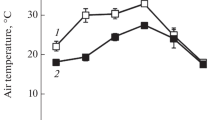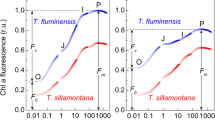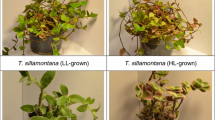Abstract
It was tested whether field-grown plants (Phaseolus vulgaris, Zea mays and Helianthus annuus) reflect photoinhibitory effects under natural conditions. Attached leaves were used for determination of the photochemical capacity of Photosystem II (Fv/Fm) by means of a portable fluorimeter (PSM, BioMonitor, S.). For a more qualitative description of Fv/Fm, the modifications of the absolute values F0, Fm as well as of the half-rise time of Fm (T/2) were also considered. By comparing artificially shaded and ‘sun exposed’ plants, the direct influence of light on the photochemical capacity was investigated. Under low natural light conditions the differences of the photochemical capacity between shaded and ‘sun exposed’ leaves were negligible in all three species. On a day with full sunlight a decline of Fv/Fm was observable at noon-time in the ‘sun exposed’ leaves of all three species, although the absolute values differed between the species compared. Additionally, the extent of the recovery of Fv/Fm was varying. Both phenomena could be due to differences in the photosynthetic apparatus (e.g., C3−C4, ontogenetic stage, sun-shade type), to self-shading phenomena (comparing leaf layers of Zea and Helianthus) or to differences in the activity of repair mechanisms possibly caused by other environmental factors (vapour pressure deficit = VPD, drought and temperature phenomena).
Nevertheless, the results of the shading experiments and the comparison of species lead to the conclusion that primarily light-induced reduction of the photochemical capacity appears at noon in leaves exposed to full sunlight, a partial restoration of Fv/Fm takes place till the evening. Artifically shaded plants show only a slight alteration of the photochemical capacity.
Similar content being viewed by others
Abbreviations
- F0 :
-
minimal fluorescence (dark), all reaction centers of Photosystem II open
- Fm :
-
maximal fluorescence (dark), all reaction centers of Photosystem II closed
- Fv :
-
variable fluorescence (dark), Fv=Fm−F0
- PI:
-
photoinhibition
References
Anderson JM, Chow WS and Goodchild DJ (1988) Thylakoid membrane organisation in sun/shade acclimation. In: Evans JR, von Caemmerer S and AdamsIII WW (eds) Ecology of Photosynthesis in Sun and Shade, pp 11–26. Melbourne, CSIRO
Assmann SM (1988) Enhancement of the stomatal response to blue light by red light, reduced intercellular concentrations of CO2, and low vapor pressure differences. Plant Physiol 87: 226–231
Baker NR and Horton P (1987) Chlorophyll fluorescence quenching during photoinhibition. In: Kyle DJ, Osmond CB and Arntzen CJ (eds) Photoinhibition, pp 145–168. Amsterdam, Elsevier Science Publ
Baker NR, Bradbury M, Farage PK, Ireland CR and Long SP (1989) Measurements of the quantum yield of carbon assimilation and chlorophyll fluorescence for assessment of photosynthetic performance of crops in the field. Phil Trans R Soc Lond B 323: 69–81
Barenyi B and Krause GH (1985) Inhibition of photosynthetic reactions by light. A study with isolated chloroplasts. Planta 163: 218–226
Björkman O (1981) Responses to different quantum flux densities. In: Lange L, Nobel PS, Osmond CB and Ziegler H (eds) Encyclopaedia of Plant Physiology, New Series, Vol 12A, pp 57–107. Berlin, Springer Verlag
Björkman O and Demmig B (1987) Photon yield of O2 evolution and chlorophyll fluorescence characteristics at 77 K among vascular plants of diverse origins. Planta 170: 489–504
Björkman O and Schäfer C (1989) A gas exchange-fluorescence analysis of photosynthetic performance of a cotton crop under high irradiance stress. Phil Trans R Soc Lond B 323: 83–86
Bolhar-Nordenkampf HR and Lechner EG (1988) Temperature and light dependent modifications of chlorophyll fluorescence kinetics in spruce needles during winter. Photosynth Res 18: 287–298
Bolhar-Nordenkampf HR, Long SP, Baker NR, Öquist G, Schreiber U and Lechner EG (1989) Chlorophyll fluorescence as a probe of the photosynthetic competence of leaves in the field: a review of current instrumentation. Functional Ecol 3: 497–514
Bongi G and Long SP (1987) Light-dependent damage to photosynthesis in olive leaves during chilling and high temperature stress. Plant Cell Environ 10: 241–249
Cleland RE, Melis A and Neale PJ (1986) Mechanism of photoinhibition: photochemical reaction centre inactivation in system II of chloroplasts. Photosynth Res 9: 79–88
Conroy JP, Virgona JM, Smillie RM and Barlow EW (1988) Influence of drought acclimation and CO2 enrichment on osmotic adjustment and chlorophyll a fluorescence of sunflower during drought. Plant Physiol 86: 1108–1115
Critchley C (1988a) The molecular mechanism of photo-inhibition-facts and fiction. In: Evans JR, von Caemmerer S and AdamsIII WW (eds) Ecology of Photosynthesis in Sun and Shade, pp 27–42. Melbourne, CSIRO
Critchley C (1988b) The chloroplast thylakoid membrane system is a molecular conveyer belt. Photosynth Res 19: 265–276
Demmig B and Björkman O (1987) Comparison of the effect of excessive light on chlorophyll fluorescence (77 K) and photon yield of O2 evolution in leaves of higher plants. Planta 171: 171–184
Demmig-Adams B, AdamsIII WW, Winter K, Meyer A, Schreiber U, Pereira JS, Krüger A, Czygan F-C and Lange OL (1989) Photochemical efficiency of photosystem II, photon yield of O2 evolution, photosynthetic capacity, and carotenoid composition during the midday depression of net CO2 uptake in Arbutus unedo growing in Portugal. Planta 177: 377–387
Dietz K-J and Foyer C (1986) The relationship between phosphate status and photosynthesis in leaves. Planta 167: 376–381
Fork DC and Satoh K (1986) The control by state transitions of the distribution of excitation energy in photosynthesis. Ann Rev Plant Physiol 37: 335–361
Havaux M and Lannoye R (1987) Reversible effects of moderately elevated temperature on the distribution of excitation energy between the two photosystems of photosynthesis in intact avocado leaves. Photosynth Res 14: 147–158
Krause GH and Cornic G (1987) CO2 and O2 interactions in Photoinhibition. In: Kyle DJ, Osmond CB and Arntzen CJ (eds) Topics in Photosynthesis, Vol 9, pp 169–196. Amsterdam, Elsevier Science Publ
Krause GH (1988) Photoinhibition of photosynthesis. An evaluation of damaging and protective mechanisms. Physiol Plant 74: 566–574
Lechner EG and Bolhar-Nordenkampf HR (1989) Seasonal and stress-induced modifications of the photosynthetic capacity of Norway spruce at the altitude profile ‘Zillertal’. A) Characteristics of chlorophyll fluorescence induction. Phyton (Austria) 29–3: 187–206
Ludlow M, Samarakoon SP and Wilson JR (1988) Influence of light regime and leaf nitrogen concentration on 77 K fluorescence in leaves of four tropical grasses: no evidence for photoinhibition. Aust J Plant Physiol 15: 669–76
Ludlow M, Sommer KJ, Flower DJ, Ferraris R and So HB (1989) Influence of root signals resulting from soil dehydration and high soil strength on the growth of crop plants. Curr Top in Plant Biochem and Phys 8: in press
Marder JB and Barber J (1989) Molecular anatomy and function of thylakoid proteins. Plant Cell and Environ 12: 595–614
Melis A, Guenther GE, Morrissey PJ and Ghirardi ML (1988) In: Lichtenthaler HK (ed) Applications of Chlorophyll fluorescence, pp 33–44. Dordrecht, Kluwer Acad Publ
Neubauer C and Schreiber U (1987) The polyphasic rise of chlorophyll fluorescence upon onset of strong continuous illumination: I. Saturation characteristics and partial control by the Photosystem II acceptor side. Z Naturforsch 42c: 1246–1254
Ögren E (1988) Photoinhibition of photosynthesis in willow leaves under field conditions. Planta 175: 229–236
Öquist G and Wass R (1988) A portable, microprocessor operated instrument for measuring chlorophyll fluorescence kinetics in stress physiology. Physiol Plant 73: 211–217
Peterson RB (1990) Effects of water vapor deficit on photochemical and fluorescence yields in Tobacco leaf tissue. Plant Physiol 92: 608–614
Powles SB (1984) Photoinhibition of photosynthesis induced by visible light. Ann Rev Plant Physiol 35: 15–44
Schreiber U and Neubauer C (1987) The polyphasic rise of chlorophyll Fluorescence upon onset of strong continuous illumination: II. Partial control by the photosystem II donor side and posssible ways of interpretation. Z Naturforsch 42c: 1255–1264
Thayer SS and Björkman O (1990) Leaf Xanthophyll content and composition in sun and shade determined by HPLC. Photosynth Res 23: 331–343
Weis E and Lechtenberg D (1988) Steady state photosynthesis in intact plants as analysed by chlorophyll fluorescence and far-red spectroscopy. In: Lichtenthaler HK (ed) Applications of Chlorophyll Fluorescence, pp 71–76. Dordrecht, Kluwer Acad Publ
Weis E and Lechtenberg D (1989) Fluorescence analysis during steady-state photosynthesis. Phil Trans R Soc Lond B 323: 27–42
Wiesner J (1907) Der Lichtgenuß der Pflanze. Vlg. Engelmann, Leipzig
Author information
Authors and Affiliations
Rights and permissions
About this article
Cite this article
Bolhar-Nordenkampf, H.R., Hofer, M. & Lechner, E.G. Analysis of light-induced reduction of the photochemical capacity in field-grown plants. Evidence for photoinhibition?. Photosynth Res 27, 31–39 (1991). https://doi.org/10.1007/BF00029974
Received:
Accepted:
Issue Date:
DOI: https://doi.org/10.1007/BF00029974




